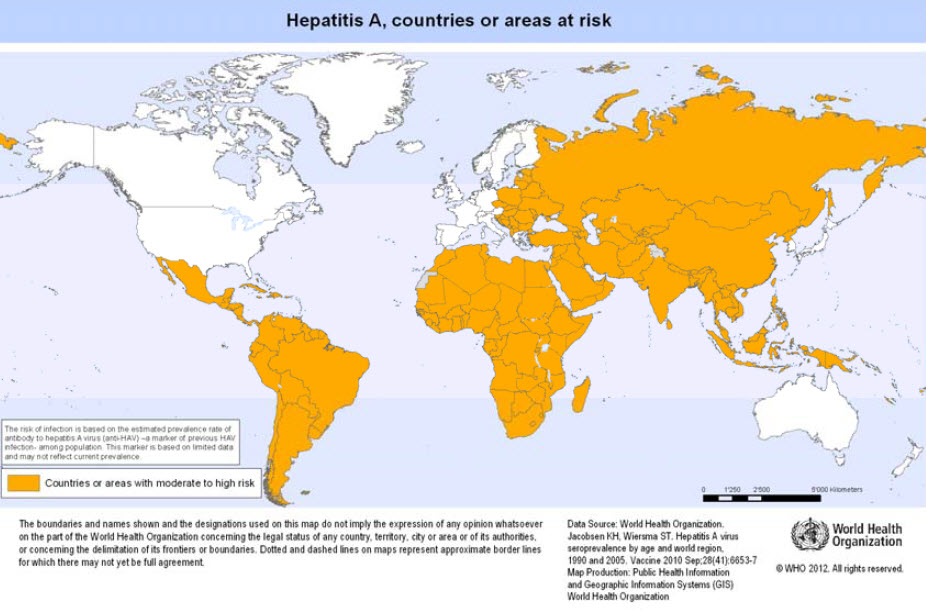Traveller vaccination hepatitis A
To read more about hepatitis A, click here.
|
Traveler Vaccination |
Editor-In-Chief: C. Michael Gibson, M.S., M.D. [1];Associate Editor(s)-in-Chief: Usama Talib, BSc, MD [2]
Disease cause
Hepatitis A virus (HAV).
Transmission
The virus is acquired through close contact with infected individuals or through faecally contaminated food or drinkingwater. There is no insect vector or animal reservoir.
Nature of the disease
Acute viral hepatitis is characterized by abrupt onset of fever, malaise, nausea and abdominal discomfort, followed by jaundice a few days later. In very young children infection is usually mild or asymptomatic whereas in older children symptomatic disease is common. The disease is often more severe in adults and full recovery may take several months. The case-fatality rate is greater than 2% for those over 40 years of age and about 4% for those aged 60 years or more.
Geographical distribution
Worldwide, but most common in areas where sanitary conditions are poor.
Risk for travellers
Non-immune travellers to developing countries are at significant risk of infection, particularly in settings with poor food and drinking-water control and poor sanitation People born and raised in developing countries, and those born before 1945 in industrialized countries, have usually been infected with HAV in childhood and are likely to be immune.
Precautions
Avoid or boil potentially contaminated food and water. Short-term protection through injection of human immune globulin is gradually being replaced by hepatitis A vaccination.
Vaccine
Two types of hepatitis A vaccines are currently used worldwide, namely formaldehyde-inactivated vaccines and live attenuated vaccines. Both types are safe and highly immunogenic and provide long-lasting, possibly life-long, protection against hepatitis A in both children and adults.
- Formaldehyde-inactivated vaccines: Inactivated hepatitis A virus vaccines are used in most countries. Monovalent inactivated vaccines are available in both paediatric dose (0.5 ml) for children aged 1 year to 15 years and adult dose (1 ml). Traditionally, a two-dose schedule is recommended, particularly for immunocompromised individuals. However, in healthy individuals, comparable effectiveness has been achieved with a single dose. A combined hepatitis A/typhoid (ViCPS) vaccine, administered as a single dose, confers high levels of protection against both these waterborne diseases. A combination vaccine that provides protection against both hepatitis A and hepatitis B should be considered for travellers who may be exposed to both organisms.
- Live attenuated vaccines (based on the H2 or LA-1 strain of HAV): These vaccines are manufactured in China and available in several other countries. Presence of anti-HAV (IgG) antibodies was documented after 15 years in 72% to 88% of the vaccinees, implying that, in most cases, long-term protection against hepatitis A is achieved with live attenuated vaccines.
Summary of vaccine data
| Considerations | |
|---|---|
| Type of vaccine |
|
| |
| Number of doses |
|
| Boosters |
|
| Contraindications |
|
| Adverse reactions |
|
| Before departure |
|
| Indication |
|
| Special precautions | None. |
